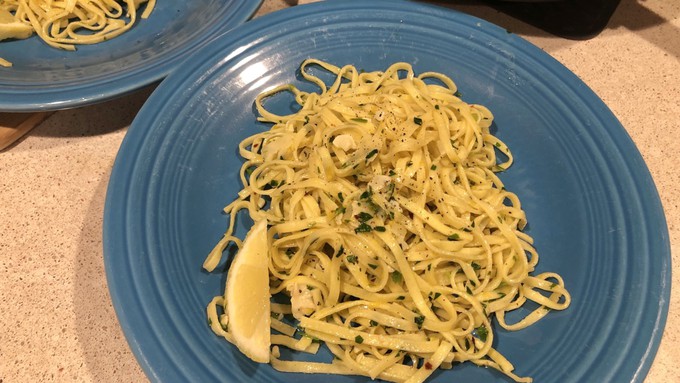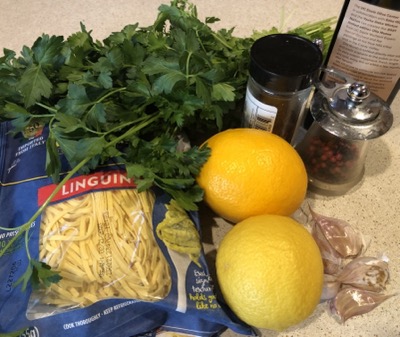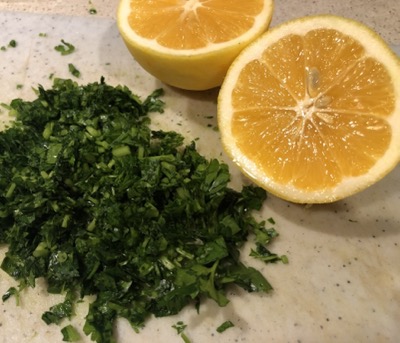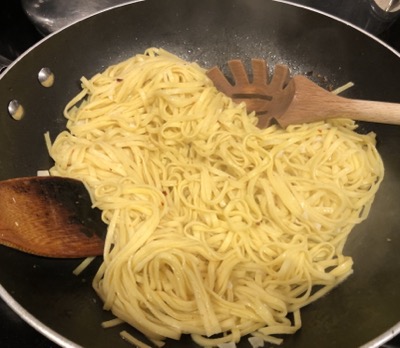
Recipe: No butter or cream in flavorful side dish

Light, flavorful and fast: Lemon pasta, made here with fresh linguine. Kathy Morrison

Anything bright and fresh is welcome these days, as winter drags into its last weeks. I found this lively citrus pasta dish while looking for yet another way to use my lemon horde.
Made without cream or butter, the pasta beautifully complements a main such as grilled fish, crab cakes or baked chicken. But I could see it as an excellent vegetarian main course -- or vegan if you leave out the Parmesan cheese.
I recommend using fresh linguine (found in the refrigerated case at grocery stores) but it also will work with dried pasta such as angel hair or thin spaghetti. The fresh packages are usually 9 ounces, not 12, so either use part of a second package, or just cook the one package -- the sauce generally will not have to be adjusted.
I've made this dish using just Meyer lemons, but I prefer the blend of zest from one Meyer lemon and one tart lemon. For juice I used the golden Meyer. And don't skimp on the garlic or the parsley. They both add depth to the sauce.
One more note: This recipe moves quickly once you start cooking, so it's important to have everything grated, chopped, etc., ahead of time and at hand.
Fresh lemon pasta
Serve 4 as a side dish or 2 as a main
Ingredients:

9 to 12 ounces long pasta, either fresh or dried (linguine seems to work best)
Salt and freshly ground black pepper
3 tablespoons good olive oil
6 garlic cloves, minced
1/2 teaspoon dried red pepper flakes, or to taste
Zest from 2 medium to large lemons (about 2 tablespoons), Meyers or tart or both
Juice from the larger lemon, about 1/4 cup
1/2 cup chopped Italian parsley
1/4 cup grated Parmesan cheese, plus more for serving
Instructions:
Put a 4-quart pot of water on to boil for the pasta. When it starts boiling, add a dash of salt, and the pasta. If it's fresh, it will cook quickly, so be prepared. Cook pasta to al dente doneness, and save out 1 cup of cooking water before draining the pasta gently and setting it aside.

In a large skillet, heat the olive oil on medium heat, then add the minced garlic and the red pepper flakes. Cook until fragrant, stirring, no more than 1 minute. Add the lemon juice and 1/4 cup reserved pasta water, then add the cooked pasta and toss, coating the pasta.
Remove the skillet from the heat and add the parsley and lemon zest to the pasta, tossing to distribute well. Add the Parmesan and, if needed, more pasta water to get the strands well-coated. Season to taste with salt and freshly ground black pepper.
Serve immediately with more Parmesan and an optional drizzle of olive oil.
Here are a few more of our citrus-with-pasta recipes:
Chill out with lemony pasta salad
Comments
0 comments have been posted.Sacramento Digs Gardening to your inbox.
Sites We Like
Garden Checklist for week of July 21
Your garden needs you!
* Keep your vegetable garden watered, mulched and weeded. Water before 8 a.m. to reduce the chance of fungal infection and to conserve moisture.
* Feed vegetable plants bone meal, rock phosphate or other fertilizers high in phosphate to stimulate more blooms and fruiting. (But wait until daily high temperatures drop out of the 100s.)
* Don’t let tomatoes wilt or dry out completely. Give tomatoes a deep watering two to three times a week.
* Harvest vegetables promptly to encourage plants to produce more. Squash especially tends to grow rapidly in hot weather. Keep an eye on zucchini.
* Pinch back chrysanthemums for bushy plants and more flowers in September.
* Remove spent flowers from roses, daylilies and other bloomers as they finish flowering.
* Pinch off blooms from basil so the plant will grow more leaves.
* Cut back lavender after flowering to promote a second bloom.
* It's not too late to add a splash of color. Plant petunias, snapdragons, zinnias and marigolds.
* From seed, plant corn, pumpkins, radishes, winter squash and sunflowers.